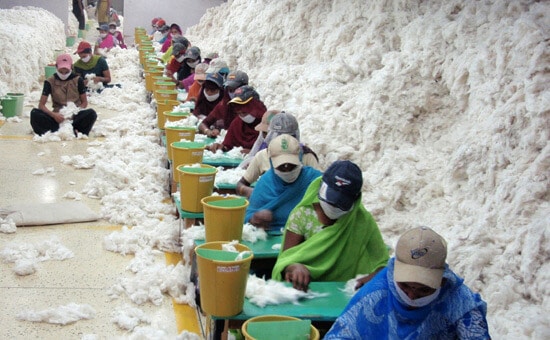In today’s world, we use cotton every day. Our clothes are made of it, we sleep in it as pajamas and bed coverings, we hang it as curtains on our windows, use it as rugs on our floors, and it is used in practice in things such as car tires and even food additives. Cotton is everywhere, and it’s interesting to hear how it starts as a tiny seed and winds up being your favorite t-shirt which looks as great as it is comfortable to wear.
Table of Contents
On the Farm: Growing and Harvesting the Crop
Of course, cotton begins by growing the cotton crop on a farm. Seeds are planted, watered, and weeded throughout the season until harvest time. This was done on a small scale in Asia, the Middle East, and Africa until the colonization of the Americas when Europeans realized the value of cotton fiber and its uses. As uncomfortable as it may be to discuss, the atrocity of slave labor allowed Early America to change cotton from a luxury item to a common fabric affordable for everyone. In the modern world, growing cotton is still hard work for the people who are part of the labor force, but machinery helps in the process and makes the amount of labor more humane in terms of working conditions.
Production from Plant to Fiber
The cotton gin was integral to cotton production, as it allowed industrial era machinery to replace what people had previously done by hand. That was in 1793, the machine has been improved upon and become far more efficient over the past 227 years. It separates the seeds from the fiber. The fiber is used to make cloth, which doesn’t always turn into that favorite t-shirt of yours, it’s also used in book bindings, more intimate items such as underwear and toilet paper, and also for carpet or other home furnishings.
The seeds are squeezed and produce oil. The oils can be an environmentally friendly alternative to traditional petroleum products, its use in car tires is one such example, or it can be processed differently and used as food additives and preservatives. Most people aren’t aware of this, but cotton oil is an integral part of everyday foods such as hot dogs, cheese, or regular vegetable oil used for cooking.
Fiber Dying
Dying the fiber can potentially take place at any step of the process, it depends on how the end product is intended to be used. The fibers are going to be cleaned and bleach in most cases before going to the spinning and weaving part of the process. In some cases, the raw fibers can be dyed, sometimes it’s more practical to dye the strings before weaving, other times it might take place after the linen has been woven. It’s rare, but it is an option to wait until the final project is completed and dye that as a single piece rather than the individual parts which led up to it.
Spinning and Weaving
When the fiber goes off to be made into fabric, it’s strung into tight heavy bales and shipped by train, boat, and tractor-trailer to go from the farm to the production facility. This isn’t the story of Rumpelstiltskin sitting at a foot-powered spinning wheel, its industrialized factory equipment turning cotton fiber into the fabric with powered machinery, stretching and bending the individual lint pieces of cotton into strings, then yarn. Weaving that yarn together is a looming process, performing a macrame process of intertwining the strings together into a piece of cloth, which can then be distributed to clothing or home goods manufacturers for cutting and sewing into the finished product. Although a loom is used for weaving, it isn’t the hobby loom or historic loom most people are familiar with. It’s a huge factory floor with dozens of employees working together to make a great end product they can be proud of.
Distribution
Once the bolt of cloth has been produced, it goes off to a clothing manufacturer, or perhaps a company which makes linens for curtain, rugs, or other cotton fabric products such as picture frame matting or perhaps pillows. Such a company cuts and sews the linen into a finished product ready for sale to the consumer. At that point, the cotton is once again re-distributed to wholesalers who in turn conduct the distribution process to get the item shipped to local retailers, so people like you and me can have nice things in our homes.
Cotton Production Parts and Machinery
This entire process happens because of companies like Certi-Pik, USA who make replacement parts for heavy industry farm equipment and small tractors used by local farms. We guarantee our products and are authorized by John Deere and Case IH to produce and sell genuine replacement parts for their equipment. We specialize in cotton harvesting equipment, but many of our products are usable in other settings, so give us a call for your farm equipment needs and one of our representatives will discuss what we can do to get your equipment back up and running so you can continue doing what you do best, growing crops and taking pride in your contribution to our country.


